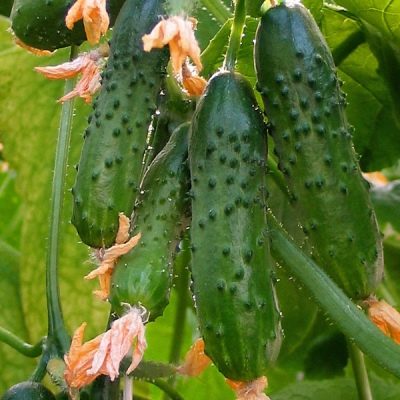
- Authors: Borisov A.V., Krylov O.N., Orekhova E.A., Krylova T.I., Goryachenkov A.V., Vostrikova O.R.
- Year of approval: 2008
- Branching: active
- Fruit weight, g: 75-90
- Fruit length, cm: 9-12
- Fruit color: green with short stripes
- Cucumber Mosaic Virus Resistance: stable
- Ripening terms: early
- Fruit shape: oval
- Fruit taste: great
Hybrid varieties of the first generation of cucumbers are distinguished by high efficiency, excellent fruiting in most regions of the country and in any agrotechnical conditions. The peculiarity of the hybrid City gherkin is that it is able to grow and bear fruit in open spaces, in greenhouses and greenhouses, as well as on balconies and window sills.
Breeding history
The originators of the hybrid are breeders Borisov A.V., Krylov O.N., Orekhova E.A., Krylova T.I., Goryachenkov A.V., Vostrikova O.R.
Description of the variety
Parthenocarpic hybrid is intended for vegetable gardens and farm fields, temporary and permanent shelters, confined spaces of apartments in the winter, balconies and loggias in the summer. He does not need third-party insect pollination.
Advantages:
yield;
early maturity;
drought resistance;
self-pollination and unpretentiousness.
The classic disadvantage of hybrids is the inability of the seed to inherit parental qualities.
Characteristics of the appearance of plants and zelents
The city cucumber is practically unlimited in growth, the length of the shoots reaches two meters or more. At the same time, they are actively branching, which forces gardeners to follow the development of culture. Scourges are covered with medium-sized, but dense leaves of bright green color. The plant bears fruit in bunches: female flowers form several ovaries in one inflorescence: from three to ten. Oval gherkins grow up to 12 centimeters, 2.1-2.7 cm in diameter, the mass of zelents is on average 75–90 g. The mid-tuberous and slightly ribbed surface of zelents is covered with small black-spiky tubercles with a light downy.
Purpose and taste of fruits
The universal hybrid is intended for fresh consumption, for slicing, summer and winter salads and whole-fruit canning. The crispy juicy pulp has a refreshing, pleasant taste with noticeable sweetness and aroma.
Maturation
The culture belongs to the early ripening category - from germination to the beginning of fruiting, on average, 40–41 days pass.
Yield
The indicators are relatively good - one square meter can give an average of 11.5 kilograms, but this is far from the limit. Creating ideal conditions will result in higher yields.
Growing regions
The city cucumber is adapted for cultivation in such regions as the North, North-West, Central, Volgo-Vyatka, North Caucasian, Srednevolzhsky, as well as the Central Black Earth Region.
Landing scheme
The optimal location between the bushes is 2.5-3 plants per square meter. m in greenhouses and 4-5 roots in the garden.
Growing and caring
The culture is grown both by seedlings and by direct sowing into the ground. The most successful time for sowing in open ground is to warm up the soil to a temperature of +16 degrees. For planting seedlings, the time is chosen when return frosts have passed.
Cultivation on the windowsill does not depend on terms or seasons - you can sow and grow all year round.It should be remembered that the roots do not tolerate stagnation of moisture, so it is advisable to equip the flowerpots with a drainage layer and a double bottom with holes for the drainage of excess moisture.
After the vegetative mass begins to develop, standard agrotechnical methods are used. These include watering, weeding, loosening, forming and organizing fertilizing.
Cucumbers are watered about 2 times a week, but much depends on climatic conditions. If hot dry weather is established, then the frequency of watering is increased. In case of prolonged rains, on the contrary, watering is reduced, up to a complete rejection of them.
Top dressing is carried out every week. At the beginning of its development, the culture needs nitrogen fertilizers, then the cucumbers need potassium-phosphorus compounds.
It is desirable to grow a hybrid in an upright position, organizing for this support in the form of a stretched twine. In order not to overload the plant with a large number of ovaries, it is best to remove the lateral shoots after the formation of two bundles. Sometimes they pinch the central stem and lead the plant in 2-3 shoots.
Soil requirements
The hybrid belongs to sun-loving crops and develops well in sunny areas. However, it retains its abilities with little shade, which allows it to be grown at home. Good soil heating is very important for the root system, therefore it is recommended to create an organic “cushion”. The bottom of the planting area is equipped with a layer of fresh manure, humus or compost, then fertile soil is poured.

In order to collect strong, tasty and beautiful cucumbers on your site, you need to make top dressing. Lack of nutrients can negatively affect the appearance of the plant and significantly reduce the yield. Fertilize cucumbers with organic fertilizers in combination with mineral fertilizers. With the right balance of these components and adherence to the fertilizing schedule, the cucumber yield will be maximum.
Disease and pest resistance
The hybrid variety has good resistance to cucumber mosaic virus, cladosporiosis and powdery mildew, while it is tolerant to downy mildew.

Despite their popularity, cucumbers are often attacked by diseases and pests. From them, cucumber plantings often die before the start of fruiting. In order to prevent this from happening, it is necessary to try to prevent ailments or get rid of them at the very beginning, having studied in detail their causes of occurrence, signs and methods of treatment.





























































































